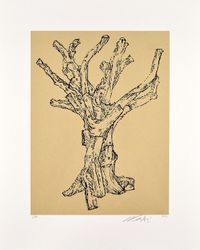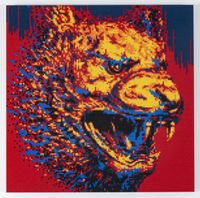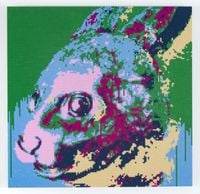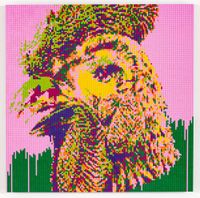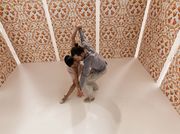Ai Weiwei is China's most recognised contemporary artist. In the past 25 years, Ai has achieved international acclaim for his large-scale installations, political activism, and frenetic online presence.
Read MoreAi is the son of renowned poet Ai Qing, a one-time member of the Chinese Communist Party who was accused of 'rightist' opposition to the government the year of his son's birth. The family was subsequently exiled to a labour camp in rural northern China, where they lived for 16 years.
After Mao Zedong's death and the ensuing end of the Cultural Revolution in 1976, the family returned to Beijing, where the young Ai enrolled in the Beijing Film Academy. It was here that he co-founded Stars Group, one of China's earliest avant-garde art collectives.
In 1981, Ai moved to the United States, where he studied at the University of Pennsylvania; the University of California, Berkeley; and Parsons School of Design in New York. However, he ultimately dropped out and made a living by working odd jobs. During this time he took a prolific amount of photographs in New York's East Village and learned about conceptual art, performance, and poetry from friends like Allen Ginsberg—lessons that would inform his developing practice.
In 1993, due to his father's illness, Ai returned to China and found it a changed nation—the pro-democracy Tiananmen Square protests had taken place just four years earlier and surges in materialism, corruption, and environmental problems had accompanied the country's rapid economic development. Inspired by his time in New York, Ai contributed to the creation of the Beijing East Village, an avantgarde artistic community comprising some of the first Chinese performance artists.
A vocal activist, Ai Weiwei has produced works that have attracted both controversy and state censure. He is well-known for his criticism of the Chinese government, an authority that employs strict censorship and is known for punishing dissenters, and is widely credited with bringing to light human rights issues in China to an international audience.
Ai's first significant performance work, Dropping a Han Dynasty Urn (1995), was met with widespread outrage. Depicting Ai dropping a 2000-year-old urn at his feet, the work drew connections between the act and Mao Zedong's stance that China must both build a new world and destroy the old one, a sentiment used to justify the sacking of cultural objects and historical signifiers during the Cultural Revolution.
Such wariness of establishment and government has come to characterise Ai's career, and is surmised in a series of photographs titled 'Study of Perspective' (1995–2003), which depict Ai giving the middle finger to structures of power such as Tiananmen Square, Hong Kong's skyline, the Eiffel Tower, and the White House.
Ai and the Communist Party first clashed in 2005, when the largest internet platform in China invited the artist to begin blogging. Ai posted a constant stream of social commentary, political criticisms, personal writing, and photographs; at one point over 100,000 people were reading per day. Due to its perceived sensitive content, the blog was shut down by authorities four years later. Ai then took to Twitter and Instagram (both banned in China), where his hundreds of thousands of followers are still able to access images of his life and work.
In 2008, tragedy struck when an earthquake hit Sichuan province and thousands of children died while studying in shoddily constructed schools. Ai launched a 'Citizens' Investigation', rallying the public to collect the names of the victims in order to memorialise them and shed light on the substandard building conditions that had contributed to the death toll. The government did not approve, and Ai was beaten by police shortly before he was scheduled to testify for one of his collaborators on the project and suffered a cerebral haemorrhage.
One of Ai's most famous photographs, Ai Weiwei in the Elevator When Taken into Custody by the Police (2009), shows him in the elevator with the policemen after the attack. Still, Ai's work about the earthquake travelled to Munich, where it was included in the exhibition So Sorry at the Haus der Kunst from October 2009 to January 2010. Displayed on the museum's façade, the installation Remembering (2009) was constructed from 9000 children's backpacks and spelled out the phrase, 'For seven years she lived happily on this earth', a quote from one of the young victim's mothers. In 2011, the artist was arrested at the Beijing airport by authorities who had branded him as a 'deviant and plagiarist'. His studios were searched, computers confiscated, and Ai and his staff and family questioned. After almost three months of harsh imprisonment, Ai was released after being charged with tax evasion. Yet his passport was confiscated for four years as the artist was 'suspected of other crimes'. He is still under close watch by authorities; indeed, the cameras installed by the police in front of his studio to monitor his activities inspired his marble sculpture Surveillance Camera (2010).
A multiplicity of materials and large scale is characteristic of Ai, who is known for repeating and modifying simple materials, as seen in the millions of porcelain seeds for his 2010 Tate Modern project 'Sunflower Seeds', and his accumulation of 886 wooden stools for his installation Bang at the 2013 Venice Biennale.
Ai's focus has since included the migrant emergencies in the Middle East. The artist has travelled extensively to refugee camps and the shores where migrants enter Europe to conduct research and document the humanitarian crisis.
Law of the Journey (2017–2018) featured a 230-foot-long inflatable raft carrying 258 faceless refugee figures, while thousands of lifejackets collected from asylum seekers in Lesbos made up the installation Soleil Levant (2017) in Copenhagen. The installation saw the façade of a major building adorned with the bright orange safety vests. Other recent projects have focused on surveillance, drones, and political prisoners.
Since 2014 Ai Weiwei has explored complex geopolitical issues, and themes of oppression and dissent through the medium of Lego bricks. He described them as 'a form that encapsulates the pixels of our contemporary digital world and personal symbol', in a conversation with Ocula.
Ai has produced Lego renditions of the Nord Stream pipeline explosion (2022), and Andy-Warhol-esque versions of the Last Supper, and Monet's monumental _Water Lilies _(1914–26) triptych.
The latter, recreated by the artist in 2022 from 650,000 bricks, features an ominous black hole in the right side of the composition, representing the door to the dugout Ai Weiwei and his father inhabited in exile in Xinjiang.
Ai Weiwei's website can be found here.
Alena Kavka | Ocula | 2021
